[PHOTO: Simon Bruty]
You’ve probably seen golf tournaments on TV where a player opts to hit a shot off a paved cartpath or has to stand on the cement because the lie is better than if the golfer took relief from the immovable obstruction. Play it as it lies is a fundamental aspect of the game.
Just last year, Mackenzie Hughes took his shoes off – seriously – believing he would have a better chance of gripping the hard surface of a cartpath with his feet than in his spiked golf shoes. That’s how motivated he was to play from a drain grate instead of taking relief. To be clear, as long as a ball is on the course and not in an area marked for mandatory relief like a no-play zone (think environmentally sensitive areas), you’re entitled to play it. Sometimes taking free relief puts the ball in a better lie. Sometimes it doesn’t.
Here’s a great photo of Dustin Johnson, during his pre-LIV Golf days, sending one from the cement in a PGA Tour event.

Getting back to the dilemma in the headline, you might wonder if you’re allowed to do the same – to still hit it – if your ball is in ground under repair or if your ball is outside the GUR area but your stance leaves your feet inside it. Maybe you like the lie, but there’s the overall concern about doing further damage to an area that needs some TLC.
The answer: when it comes to ground under repair, it’s your choice. Take relief or play your ball from that sweet lie (Rule 16.1a). You might make the damage worse to the GUR, but the course superintendent is the only one who will probably take issue. Now, a local rule might make taking GUR relief compulsory, in which case you must, but otherwise you can choose to play on from the GUR situation if you wish.
Incidentally, the outside edge of the stakes or paint lines that mark the area are also considered ground under repair. If your ball, stance or area of intended swing is interfered with by this abnormal course condition and you decide to take relief, you must find the nearest point of complete relief from the ground under repair and drop your original ball or another ball clear from it and within one club length of that point, not nearer the hole. There is no penalty.
Getting back to areas on the course marked as no-play zones, this is the one instance where you must take relief even if your ball is not in the zone but your area of intended stance or intended swing would be interfered with by the NPZ. If you’re wondering how no-play zones are typically marked, the Rules of Golf doesn’t designate a specific colour of stakes or lines, but the following is recommended: penalty area no-play zones should have red or yellow stakes with green tops. Abnormal course condition no-play zones should have white or blue stakes with green tops.
